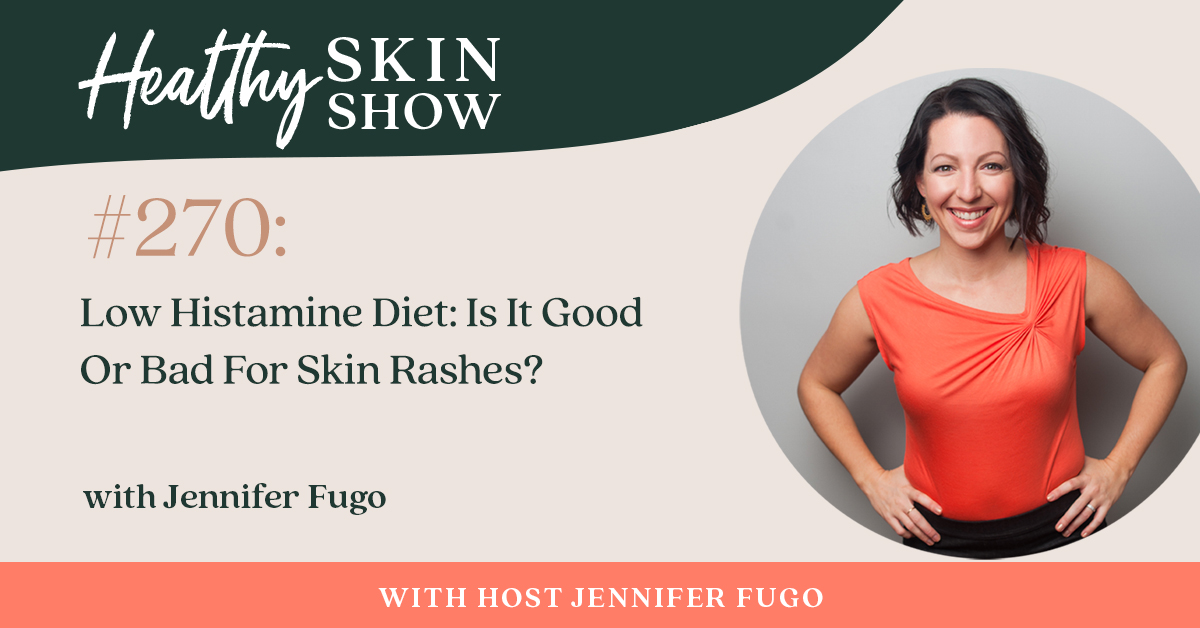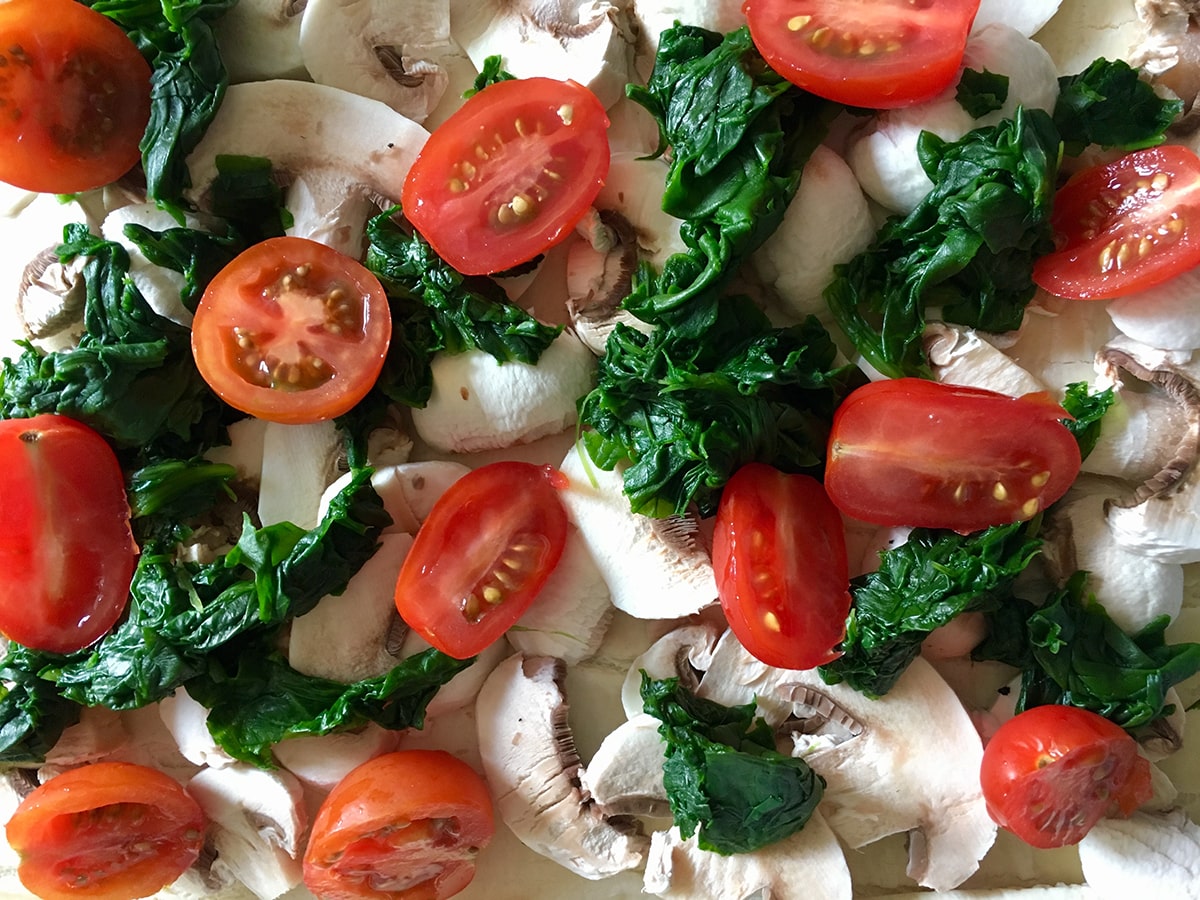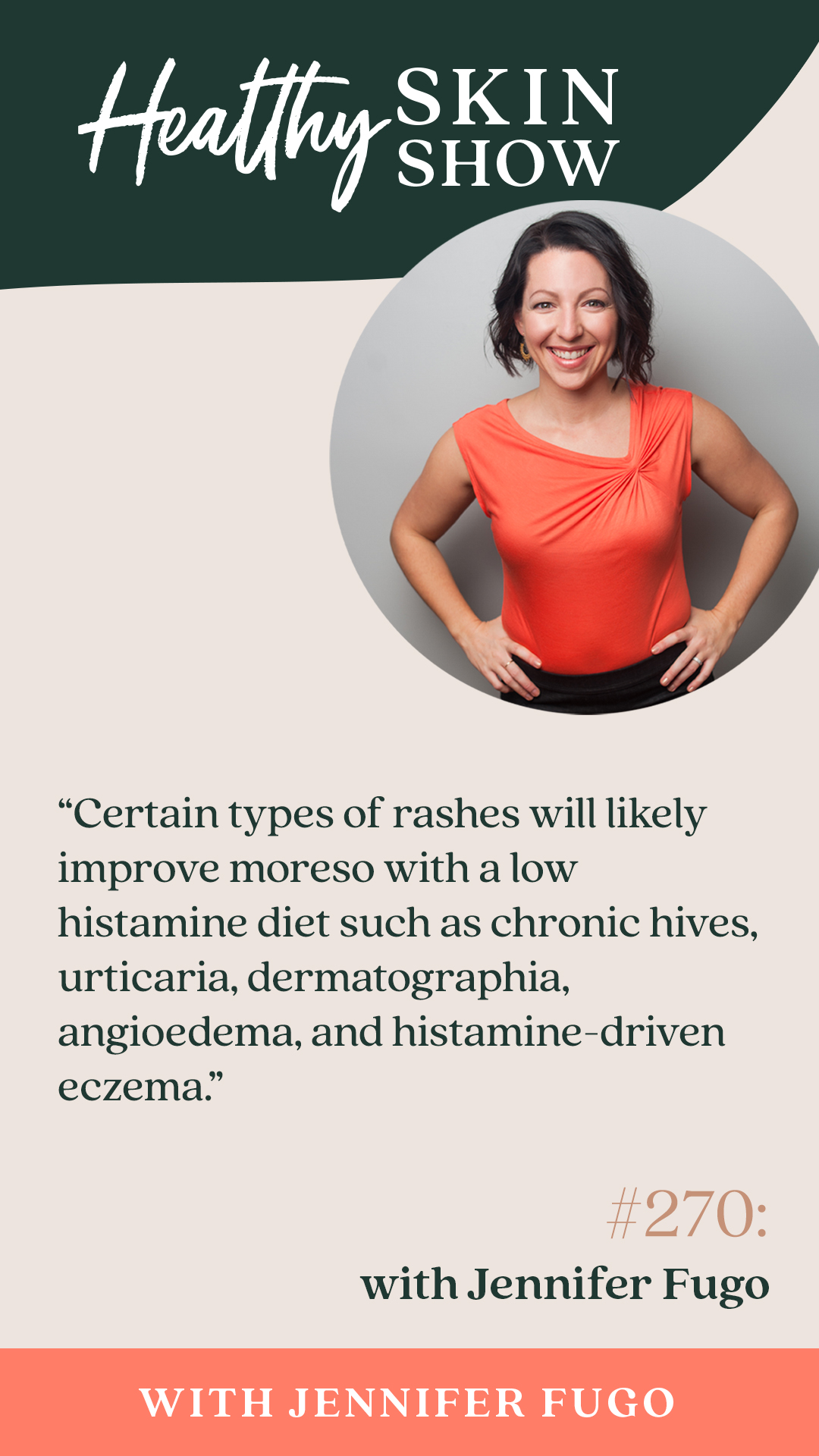
This episode is bought to you by Quell — to help support rebuilding healthy skin from the outside-in + inside-out!
Take 10% off your next order! Use promo code QUELL10 at check out — Get started HERE!
– – –
If you’ve been seeing more online about doing a low histamine diet to help your skin rash problems, you’re not alone.
I’m also seeing this happen on the clinical side of things – clients previously been advised by practitioners to reduce high histamine foods because of itchiness in the hopes that their rashes would improve.
This might explain why I frequently get messages + emails asking me if a low histamine diet would be a helpful next best step.
Rather than writing out a lengthy response to each person (because a one word response is no where near sufficient), I figured it was time to share my thoughts.
My answer often surprises people because it’s not what they’d expect.
So that’s what I’m digging into today with the hope that the nuance will help you make a more informed choice for yourself about whether a low histamine diet is worth a try (or not).
Or, listen on your favorite app: iTunes (Apple Podcasts) | Spotify | Stitcher | TuneIn | Subscribe on Android
In this episode:
- Helpful criteria to figure out if doing a low histamine diet would be worthwhile
- Biggest problems with a low histamine diet (no one tells you ahead of time)
- List of chronic skin issues that might improve
- How strict do you need to be on the diet to get results?
- Should you stay on a low histamine diet for life?
Quotes:
Certain types of rashes will likely improve moreso with a low histamine diet such as chronic hives, urticaria, dermatographia, angioedema, and histamine-driven eczema.
As a rule of thumb, more food restrictions in general do not necessarily equate to being healthy.

270: Low Histamine Diet: Is It Good Or Bad For Skin Rashes? (FULL TRANSCRIPT)
Welcome back to episode #270 of the Healthy Skin Show!
In today’s episode, I’m offering a response to a question that I commonly get – “is the low histamine diet good for skin rashes?”
What makes this question relevant now is that I find that functional practitioners + doctors are recommending a low histamine diet more frequently.
And that’s fine assuming two things:
- The diet is warranted given a deep review of the case.
- The diet is generally used as a bridge to manage symptoms while working on other deeper problems lurking under the surface so you can eventually transition off of it.
The reason I explicitly state that you should eventually transition to a broader diet is that…
The low histamine diet is extremely difficult to follow.
It also can result in a deep near-hatred of food for some.
I believe I shared on another episode that most people whom I’ve worked with have admitted to me that after doing the low histamine diet, they would prefer NOT to eat if they didn’t have to.
That’s an unfortunate and concerning reality for people to find themselves in, which at this point in time hasn’t completely sunk in within many practitioner circles.
I’m not saying that you should avoid this diet at all costs, but the question I shared at the beginning of this episode – “is the low histamine diet good for skin rashes?” – isn’t the right question to ask.
It’s not a matter of whether a low histamine diet is good for skin rashes.
Instead, it’s a question of whether a low histamine diet is necessary AND appropriate.
And figuring THAT out is crucial. It’s not a diet to just try because you’re trying to rule things out or bring down inflammation.
Because if you don’t have histamine intolerance or even Histamine Overload (which I talk a lot about here on the Healthy Skin Show), then this likely isn’t the right intervention to try.
So let’s talk about those two criteria I mentioned to help you figure out if doing a Low Histamine Diet is the next best step for you!

Low Histamine Diet – Is It Right For You?
The first point that I made earlier is that there has to be a clear reason present to even start the low histamine diet.
It’s not a diet that you pick on a whim or try because your health isn’t what you want it to be.
A low histamine diet will generally be helpful if you struggle with histamine intolerance or a situation that I describe as Histamine Overload (more HERE in episode 188).
Certain types of rashes will likely improve moreso with a low histamine diet such as chronic hives, urticaria, dermatographia, angioedema, and even histamine-driven eczema cases (though as I’ve already shared in episode 248, not all eczema cases are histamine-driven).
That said, assessing a case for histamine overload is extremely important because certain situations can look like a histamine problem when it’s actually not (an example of this would be Topical Steriod Withdrawal which is often confused for severe eczema or histamine intolerance).
So getting assessed for histamine intolerance or Histamine Overload is crucial before bothering to dive into a low histamine diet.
If you do not have someone to help you figure out if a low histamine diet would be helpful, check out the list of concerns and symptoms in episode 188 of the Healthy Skin Show on Histamine Intolerance + Skin Rashes (Part 1).
Because – and I need to be brutally honest here – a low histamine diet is pretty awful.
I generally feel bad suggesting it a client and I will often try to find the “lightest” version of the diet that will get results.
So no, you do not need to cut everything out and strictly do a low histamine diet – if it’s not necessary! Severity will dictate how low histamine you need to go.
There are variations to this where you start by removing the foods with the largest histamine content and see if this improves symptoms first.
This would include alcohol, fermented foods like vinegars, kombucha, soy sauce, sauerkraut, kimchi, aged cheeses, cured meats, bone broth, strawberries, spinach, tomato, chocolate, coffee (except possibly from Purity which may be tolerable to those with histamine issues) and such.
If more is needed, then you dive a bit deeper and try removing other foods that may be problematic like leftovers, protein powders, collagen, gelatin, dried spices + fish (unless it was very quickly frozen after being caught).
And if you still need to go further, then we’re looking at the list of other possibly problematic foods like citrus or bananas which don’t contain high levels of histamine, but may be an issue for some and are often listed as being high in histamine.(1)
The truth is that if you find this conversation confusing about which foods are best to avoid on a low histamine diet, you’re not alone. There’s not a great deal of science behind these lists so while some items (like fermented foods) make sense, some might not.(1)
I should add that diet changes may be more successful with the addition of certain supportive supplements like immunoglobuins, bioflavinoids, and quercetin. While antihistamines may be helpful, long-term use of these medications (even those that are over-the-counter) can also have some concerning potential side effects.

What’s Causing Your Histamine Intolerance?
So if you know that it’s highly likely that you have histamine intolerance or histamine overload…
AND you’re now doing a low histamine diet…
Are you looking for and dealing with the underlying drivers of the condition?
Too many people assume that they have a DAO enzyme deficiency which I don’t think is nearly as common as is claimed online.
Because they feel somewhat better on the low histamine diet, there also is a dangerous temptation for some to just continue eating that way.
However I find that the diet is difficult to sustain due to the amount of restriction and leads to disordered eating, food fear, and, even in some cases, disgust of food or having to eat at all. On top of which there can be a sense of tremendous social isolation, feeling like you’re doomed, and depression negatively impacting your quality of life.
That’s why I view the low histamine diet as a bandaid.
It can certainly be helpful for those really struggling with intense symptoms, but it ultimately will not fix the underlying problem.
For most, there’s something else going on under the surface and/or in the environment (like mold exposure) which is why your histamine reactivity is so high + pronounced.
The diet itself must be coupled with a plan to investigate underlying triggers as well as a roadmap to start dealing with them.
Ultimately I like to start reintroduction attempts with higher histamine foods within two to four months after starting the diet assuming that the supplement support is dialed in and the client is feeling better as we reduce the deeper root causes.
If you’re listening to this thinking that you would be stuck on this diet forever and haven’t delved into the potential issues surrounding Histamine Overload, I’d highly recommend that you dig deeper into the many resources that I’ve created for you HERE.
This is a very common problem that I work with in my private virtual clinic so it’s something we assess for from the start.
I think that histamine intolerance is actually a bigger, broader issue which I call Histamine Overload. And it also explains why people don’t always get better and may get stuck on an overly restrictive diet.
As a rule of thumb, more food restrictions in general do not necessarily equate to being healthy.
The decision to remove specific foods ultimately comes down to a variety of factors including whether the shifts are necessary and warranted while at the same time looking for other reasons beyond the food itself that could be driving the problems in the first place.
So before you jump on the low histamine diet bandwagon or take advice to do this diet from what you’re reading online, consider what I’ve shared with you today so you can make a more informed decision based on the specifics in your case.
If you’ve got any questions or thoughts to share about this, leave a comment below so I can address them.
And take a moment to share this thought based on my clinical experience with fellow skin rash warriors who might not realize that there’s more to consider before diving headfirst into a low histamine diet!
Thank you so much for tuning in, and I look forward to digging deeper with you in the next episode!

REFERENCES

Jennifer Fugo, MS, CNS
Jennifer Fugo, MS, CNS is an integrative Clinical Nutritionist and the founder of Skinterrupt. She works with women who are fed up with chronic gut and skin rash issues discover the root causes and create a plan to get them back to a fuller, richer life.





